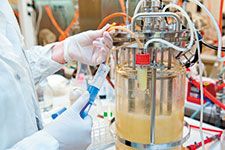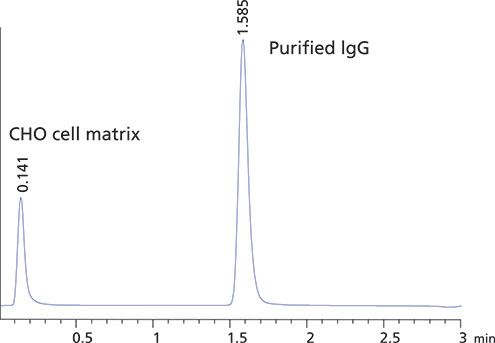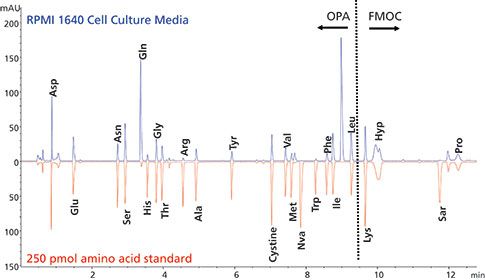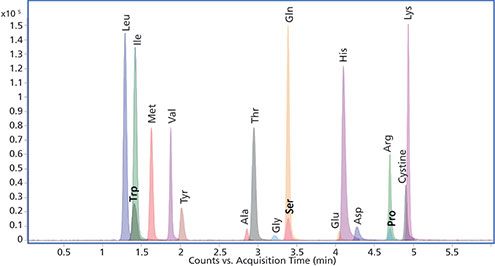Bioreactor Monitoring: More to Measure than Glucose In, mAb Out
This article discusses affinity capture for tier determination and surveys a broad collection of commonly and less commonly used assays to analyze cell culture media
borzywoj/Shutterstock.com

Bioprocessors house a complex ecosystem of host cells, nutrients, secreted metabolites, and biotherapeutic product-often a monoclonal antibody (mAb). In the production of biotherapeutic proteins, this mixture is carefully optimized and closely monitored. The amount of biotherapeutic protein produced is of critical importance. The process of quantifying that product is referred to as titer determination. During development, the composition of the cell-culture media is carefully optimized for maximum yield with as few impurities as possible. Process understanding and control are vital for the regulatory approval of new biotherapeutics, and the fermentation process in the bioreactor is one key aspect.
In addition to measuring how mAb production relates to the identity and quantity of nutrients provided, excreted metabolites may also be monitored as measurements of the host cell’s health and productivity. Following clone selection in the development stage, scale up of production is another phase where titer determination and spent media analysis may play a significant role. Finally, during production, titer determination is used to decide when to harvest. The composition of the culture media may be analyzed to ensure that the cells have plenty of necessary nutrients, to monitor reactor kinetics, and to keep an eye out for excreted metabolites that could warn of trouble.
Titer determination
Affinity capture coupled with ultraviolet (UV) detection is by far the most common approach to titer determination. In the case of monoclonal antibodies, that usually means Protein A capture, though there are other options, such as Protein G for IgG3 antibodies, or Protein L for those with kappa light chains. Biotherapeutics that are not mAbs will require another affinity capture approach, such as adding a polyhistidine tag for capture with immobilized nickel or adding a strep tag to the protein target for capture with immobilized streptavidin.
Affinity capture is a simple two-step process. The sample is loaded onto the column and bound while the sample matrix flows through, then an elution buffer is used to elute the target protein. In the case of Protein A, the sample is loaded using a neutral pH mobile phase (often with a phosphate buffer), followed by elution with a low pH mobile phase such as a citric or acetic acid solution. The low pH disrupts binding of the IgG to Protein A, eluting it from the column. For other affinity capture approaches, the elution buffer typically contains a free ligand that competes with the target protein for binding to the stationary phase. In the case of a His-tagged protein, an imidazole solution is commonly used to disrupt the interaction between the target protein and the immobilized nickel.
Recombinant Protein A that has been genetically modified for increased stability is often preferred for the longer column lifetime that is enabled by the more robust Protein A. However, an unmodified, native Protein A may sometimes be favored because of its tighter binding with certain IgGs, which may allow for higher sensitivity measurements of these species.
In a titer experiment, accuracy is critical, but other key factors include speed, specificity, a wide dynamic range, and robustness. Many laboratories need titer determinations on a large number of samples, but even when this is not the case, information may be needed rapidly in order to make a decision as soon as possible. Many commercially available Protein A products enable separation of IgG from matrix in as little as two to three minutes. The affinity capture is ideally specific, yielding a highly pure protein product. A wide dynamic range ideally allows for both good sensitivity as well as quantitation of relatively concentrated samples without dilution (see Figure 1).
Figure 1: IgG purified from Chinese hamster ovary (CHO) cell extract using an Agilent Biomonolith Protein A column on a 1260 BioInert LC [all figures courtesy of the author].

While using recombinant Protein A certainly contributes to a robust separation, the column format also plays a role. At the analytical scale, Protein A columns are available both as conventional columns packed with particles or as monoliths. Monoliths have a channel structure rather than a pore structure and are less likely to clog due to cell debris from host cell proteins. The benefit of a particle platform is that they can be packed into columns of virtually any size or material, making them a flexible option for scale up.
In a production setting, an abnormal protein titer may be the first indication of trouble in the bioreactor, and spent media analysis may offer insight into the source of the problem.
Spent media analysis
Spent media analysis looks at the rest of the fermentation mixture-mainly the small molecule nutrients that are provided to the cells and the small molecule metabolites that are excreted. The primary nutrients in cell-culture media are the standard amino acids, water-soluble vitamins (e.g., B1 through B6), and glucose. Nutrients, such as glucose and glutamine, and excreted metabolites, such as lactate and ammonia, are indicators of cell culture kinetics-how fast nutrients are metabolized into waste products. Amino acids may be rate-limiting nutrients for growth and production, hence the need to optimize the amount of each amino acid supplied, and monitor the rate at which they are consumed. Vitamins, metal ion cofactors, or other nutrients may also be analyzed when doing in-depth media development. Beyond the energy-related metabolites, other excreted metabolites may be indicators of cell health. For example, polyamines, such as spermidine or putrescine, are exported by cells. These compounds are breakdown products of amino acids and, among other functions, serve as growth factors for cell division.
A variety of assays may be used to monitor individual nutrients or classes of nutrients or metabolites separately. As the main energy source, glucose is a critical nutrient to monitor, many convenient kits are available for glucose monitoring. Many of these are biosensor-based, using glucose oxidase or glucose peroxidase to react the glucose followed by either electrochemical or colorimetric detection. Lactate is often similarly measured by oxidation with lactate dehydrogenase followed by electrochemical or colorimetric analysis. Other metabolites of interest may be monitored by an assortment of mainly liquid chromatography (LC)/UV-based techniques, often requiring derivatization, where interferents must be removed to successfully detect the target.
Liquid chromatography with UV detection has been the ubiquitous approach to analyzing amino acids for decades. Amino acids themselves do not have an optically active chromophore, so derivatization is required for UV or fluorescence detection. The historic approach to this has been to use a cation exchange separation, then post-column derivatization with reagents such as ninhydrin, fluorescamine, or OPA (ortho-phthalaldehyde) prior to UV detection. Alternatively, samples may be derivatized, either offline or online, prior to a reverse-phase chromatographic separation. Unlike underivatized amino acids, the derivatized amino acid product is sufficiently hydrophobic to be retained on a reverse-phase column. Offline derivatization may be done manually or by automation, and example offline derivatization reagents include OPA and fluorenylmethoxy chloroformate (FMOC), 6-aminoquinolyl-N-hydroxysuccinmidyl carbamate (AQC), phenylisothiocyanate (PITC), dansyl chloride, or benzylisothiocyanate. When using offline derivatization, the lifetime of the derivatized product must be considered to ensure that analysis is completed before the sample degrades.
Online precolumn derivatization eliminates the errors associated with manual sample preparation, frees the analyst to perform other tasks, and enables the samples to be analyzed immediately following derivatization, removing any concern of sample degradation. It is the surest way to achieve highly consistent, reproducible results. Derivatization of primary amino acids with OPA followed by derivatization of secondary amino acids with FMOC may be readily performed in a suitably equipped autosampler of the LC instrument used to separate and detect the amino acids. Using two separate derivatization reagents to distinguish primary from secondary amino acids improves selectivity and simplifies analysis. In a reverse-phase separation, all OPA-derivatized primary amino acids will elute before the first FMOC-derivatized secondary amino acid (see Figure 2).
Figure 2: Top chromatogram (blue), RPMI 1640 cell culture media, bottom chromatogram (red) 250 pmol amino acid standard. Analyzed by reverse-phase liquid chromatography/UV (LC/UV) using an Agilent AdvanceBio Amino Acid Analysis column, with ortho-phthalaldehyde/fluorenylmethoxy chloroformate (OPA/FMOC) derivatization, on a 1290 Infinity LC.

Figure 2: Top chromatogram (blue), RPMI 1640 cell culture media, bottom chromatogram (red) 250 pmol amino acid standard. Analyzed by reverse-phase liquid chromatography/UV (LC/UV) using an Agilent AdvanceBio Amino Acid Analysis column, with ortho-phthalaldehyde/fluorenylmethoxy chloroformate (OPA/FMOC) derivatization, on a 1290 Infinity LC.
LC/UV analysis of amino acids has the advantage of being well established, widely used, and extremely robust. Relative to other analytical approaches, LC/UV requires relatively little expertise or capital investment. For many laboratories, the low picomole sensitivity of UV detection is sufficient, and switching to fluorescence detection provides up to an order of magnitude more sensitivity. Other than the time spent on sample derivatization, the drawbacks of LC/UV detection are primarily due to its lack of specificity. All analytes of interest must be chromatographically resolved, which limits throughput. Analysis is also limited to compounds that react with the chosen derivatization reagent. In the case of OPA/FMOC derivatization, this means only primary and secondary amines may be detected by this approach. Any other important nutrients or metabolites must be analyzed by other means.
LC/mass spectrometry (MS) analysis overcomes many of the limitations associated with LC/UV methods for amino acid analysis. The specificity of MS detection means that only isomers must be chromatographically resolved. Also, no chromophore is required for MS detection, making derivatization unnecessary. Ultimately, one will be able to appreciably decrease analysis time.
In addition to removing the restriction to only compounds that react with the derivatization reagent, a much wider array of metabolites will readily ionize than contain a chromophore for UV detection. This flexibility enables one to analyze a variety of nutrients and excreted metabolites in a single analysis. For example, amino acids, glucose, lactate, and other anionic metabolites may be measured in the same assay, saving even more time. An extra benefit is the increase in sensitivity that may be achieved by moving to MS detection. The most sensitive triple quadrupole instruments can readily measure into the femtomole range.
While LC/MS is a powerful approach to spent media analysis, it is not without its challenges. For most laboratories, MS represents a significantly higher investment in both instrumentation and expertise than UV-based methods. Increased demand for the specificity and sensitivity of MS detection, however, has led vendors to develop more affordable, fit-for-purpose instrumentation. For spent media analysis without stringent sensitivity demands, a cost-effective single quadrupole instrument may be all that is needed.
The change to MS detection also requires a change to the previously used chromatographic approaches. As previously mentioned, underivatized amino acids are too polar to be retained on a reverse-phase column using a standard reverse-phase method. One solution is to use ion-pairing mobile phase additives to retain these polar metabolites. Ion-pairing reverse phase methods can be robust. However, they require dedicated instrumentation as ion pairing reagents are exceedingly difficult to remove from an LC system. On the other hand, hydrophilic interaction chromatography (HILIC) can be implemented on the same instrument as other methods without issue. By using volatile salts such as ammonium acetate or ammonium formate, HILIC may be readily coupled with MS detection (see Figure 3).
Figure 3: Amino acids from cell culture media. Analyzed by hydrophilic interaction chromatography (HILIC) liquid chromatography/mass spectrometry (LC/MS) using an Agilent AdvanceBio MS Spent Media column, 1290 Infinity II LC, and 6230 TOF mass spectrometer.

Figure 3: Amino acids from cell culture media. Analyzed by hydrophilic interaction chromatography (HILIC) liquid chromatography/mass spectrometry (LC/MS) using an Agilent AdvanceBio MS Spent Media column, 1290 Infinity II LC, and 6230 TOF mass spectrometer.
Historically, HILIC methods have struggled to achieve the required robustness and reproducibility, but recent additions to the column market have made significant improvements in this respect. HILIC chemistries that offer reproducible separations under a variety of sample salt concentrations are valuable for cell culture analysis. Given the vastly different structures and polarities of metabolites, a column that retains a range of polarities, such as a zwitterionic HILIC chemistry, is important, especially for expanding an assay beyond amino acid analysis.
Finally, as shown in Figure 4, an inert, metal-free flowpath, including both the column and the LC instrumentation, can be critical to detecting challenging metabolites such as polyamines or nucleotides.
Figure 4:

Figure 4: Polyamine standards illustrating the difference in peak shape when using stainless steel column hardware (top row, red chromatograms) versus PEEK-lined stainless steel hardware (bottom row, blue chromatograms). Both columns have the same packing material. The metal-free flow path improves detection of “sticky” compounds.
Like the move toward multiplexing various spent media assays into a smaller number of analyses, biotherapeutic production as a whole is moving toward higher efficiency. Continuous production is increasingly preferred over batch production as one aspect of process analytical technology (PAT). PAT is the framework to design, analyze, and control manufacturing processes by real-time monitoring of critical process parameters that affect critical quality attributes of the biotherapeutic product (1). The ability to rapidly determine titer and analyze spent media, ideally online sampling, is a key tool toward ensuring efficient production of uniform biotherapeutics.
Author’s note: This article is for research use only and not for use in diagnostic procedures.
References
1. FDA, Guidance for Industry PAT–A Framework for Innovative Pharmaceutical Development, Manufacturing, and Quality Assurance (CDER, September 2004), www.fda.gov/downloads/drugs/guidances/ucm070305.pdf
About the Author
Anne Blackwell, PhD, is Bio Columns Product Support Scientist, Agilent Technologies.
Article Details
BioPharm International
Vol. 31, No. 6
June 2018
Pages: 14–19
Citation
When referring to this article, please cite it as A. Blackwell, "Bioreactor Monitoring: More to Measure than Glucose In, mAb Out," BioPharm International 31 (6) 2018.
